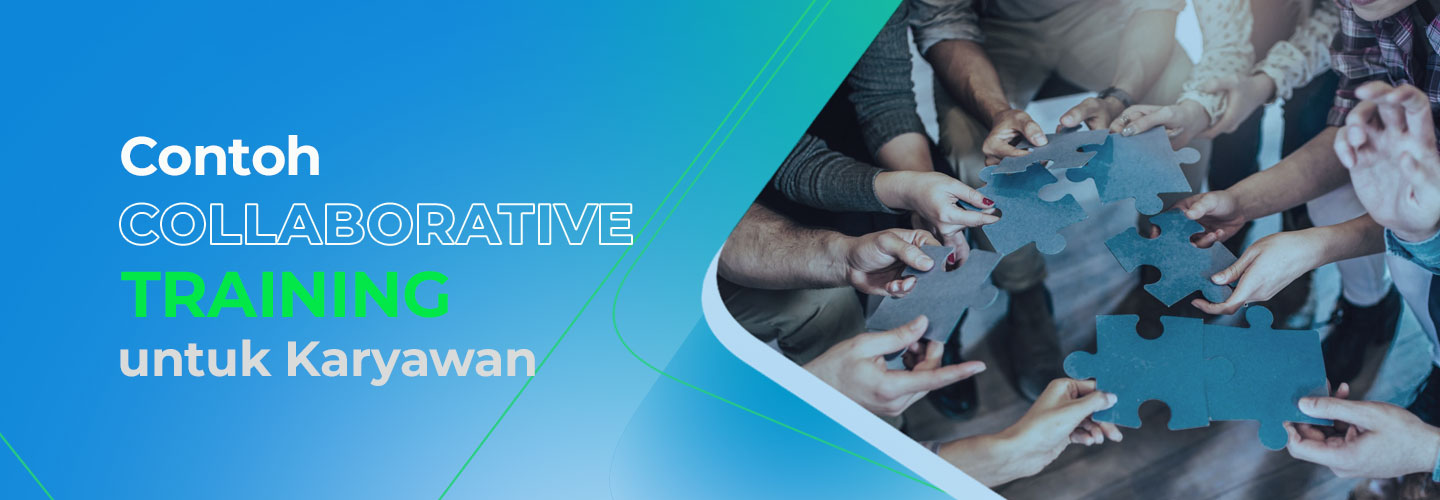Contoh Collaborative Training untuk Karyawan

Perusahaan menganggap pengetahuan sebagai salah satu aset penting yang harus dimiliki oleh karyawan. Oleh karena itu, untuk menjaga dan mengasah kemampuan karyawan, perusahaan seringkali melakukan training. Namun, selama beberapa tahun terakhir, model training untuk karyawan sudah banyak berubah.
Perubahan yang paling signifikan adalah training yang berfokus pada individu dan berbasis teks berkurang. Saat ini mulai banyak bermunculan collaborative training. Sebuah metode training yang mencakup beberapa teknik untuk memaksimalkan pembelajaran dan keterlibatan karyawan, sehingga memungkinkan mereka untuk saling membantu.
Manfaat dan jenis collaborative training untuk karyawan
Daripada melakukan pembelajaran secara individu, mendengarkan sudut pandang lain, berbagi ide, dan menyampaikan poin secara kelompok, akan membuat karyawan memperoleh pemahaman yang lebih baik. Hal ini membuat collaborative training sebagai teknik yang efektif untuk pelatihan karyawan di tempat kerja.
Sebagai seorang manajer atau pemimpin tim, Anda perlu memastikan bahwa anggota tim Anda mendapatkan pembelajaran yang efektif. Oleh karena itu, collaborative training dapat Anda terapkan di pada anggota tim. Untuk lebih jelasnya, berikut contoh collaborative training yang dapat Anda lakukan di tempat kerja:
1. Buat komunitas belajar
Untuk memenuhi tujuan dan menemukan solusi masalah, collaborative training mendorong kerja sama. Proses pelatihan seperti ini memprioritaskan komunikasi terbuka dan memberi individu kesempatan untuk belajar dan berbagi dengan orang lain.
Untuk membangun komunitas belajar berikut beberapa hal yang dapat Anda lakukan:
-
dengan mempertimbangkan tujuan yang ingin dipenuhi, kembangkan komunitas belajar berbasis tujuan.
-
mendorong komunikasi yang aktif dalam masyarakat.
-
membentuk pemimpin yang dapat mewakili komunitas. Seorang pemimpin kelompok harus memastikan tujuan komunitas terpenuhi dengan cara yang paling sesuai dengan komunitas belajar mereka.
-
setiap orang memiliki gaya belajar, kelebihan, dan kelemahan yang berbeda-beda. Di sini komunitas belajar harus dapat memahami dinamika kelompok, mengadaptasi strategi dengan mempertimbangkan anggota kelompok lain, dan memastikan bahwa semua orang berkontribusi dan membangun ide satu sama lain.
2. Pelatihan dari tim atau departemen lain
Cara lain yang sederhana, tetapi efektif adalah dengan meminta tim atau departemen yang berbeda untuk melatih kelompok lain. Pada sesi ini ajarkan karyawan tentang tanggung jawab masing-masing tim atau departemen. Sesi ini memungkinkan tim untuk berbagi pengalaman dan tugas mereka kepada seluruh karyawan dan memungkinkan mereka untuk memberikan pengetahuan tentang cara untuk memecahkan masalah yang mungkin akan melibatkan bidang keahlian mereka.
3. Peer review
Peer review adalah pembelajaran dua arah yang memungkinkan karyawan untuk melihat dan termotivasi karena pekerjaan satu sama lain. Metode ini memungkinkan karyawan untuk mendapatkan feedback dari orang lain selain manajer, sehingga akan membantu karyawan untuk belajar lebih banyak. Salah satu yang mereka akan dapatkan adalah cara menyampaikan pendapat dan ide tanpa rasa malu, ragu, dan takut.
Agar efektif, berikut cara menerapkan peer review untuk karyawan:
-
manajer memilih rekan untuk masing-masing karyawan
-
manajer mengkomunikasikan tujuan evaluasi kinerja kepada tim. Tujuan evaluasi ini agar dapat saling membantu dan menjadikan karyawan yang profesional dan terbaik.
-
dengan menggunakan internet atau software yang memudahkan proses review, informasi dan penilaian penting dari karyawan dapat didapatkan dan dibuat lebih efisien
-
izinkan karyawan untuk memberikan pandangan dan pendapat
-
untuk feedback lakukan pertemuan empat mata dengan karyawan
4. Rekan kerja virtual
Jangan lupakan karyawan jarak jauh atau bahkan mereka yang bekerja di zona waktu berbeda. Salah satu kelebihan collaborative training adalah memungkinkan karyawan yang beraktivitas secara virtual, sehingga mereka yang bekerja jarak jauh akan merasa terhubung dengan tempat kerja dan menjadi lebih produktif.
Untuk menerapkan kerja sama secara visual, berikut yang harus Anda perhatikan:
-
untuk mengatur komunikasi gunakan online tools, seperti Slack atau Microsoft Teams
-
tim dan manajer menjadwalkan pertemuan virtual secara rutin dengan karyawan
-
berinvestasi untuk software yang akan digunakan
-
buat transparansi karir dengan tujuan bulanan yang terukur bagi setiap karyawan, sehingga tercipta akuntabilitas pada karyawan
-
agar tetap dapat terhubung dan belajar dengan karyawan yang lain, buat workshop untuk karyawan yang remote
5. Think-pair-share
Think-pair-share adalah salah satu strategi collaborative training untuk menghasilkan pembelajaran yang tepat, dan aktif. Sesuai dengan namanya, teknik Think-Pair-Share melibatkan tiga tahap: think (brainstorming tentang suatu topik), pair (membuat kelompok), dan share (kelompok mendiskusikan ide-ide yang mereka miliki). Tidak hanya lebih terstruktur, teknik ini juga mendorong karyawan untuk berpikir lebih kritis.
Untuk lebih jelas, berikut tahapan Think-pair-share yang harus Anda lakukan:
-
tahap pertama, Anda atau pemimpin tim harus memutuskan pertanyaan atau masalah yang ingin dibahas. Kemudian karyawan akan diberikan waktu beberapa menit untuk memikirkan topik yang akan diberikan
-
tahap kedua, kelompok yang beranggotakan dua atau tiga orang dipersilahkan untuk berdiskusi
-
pada tahap ketiga diskusi sudah diperluas. Karyawan berbagi jawaban mereka.
6. Pemecahan masalah secara bersama
Selama jangka waktu yang ditentukan, kelompok diberikan studi kasus untuk dipecahkan. Teknik ini akan membantu meningkatkan komunikasi, produktivitas tim, dan memotivasi pembelajar untuk mencari pemahaman konsep yang lebih mendalam.
Untuk menerapkan pemecahan masalah kelompok, berikut beberapa cara yang dapat Anda lakukan:
-
identifikasi masalah yang dihadapi tim dan cari tahu penyebabnya
-
untuk memandu sesi pemecahan masalah, pilih seorang yang dapat memimpin tim
-
setiap karyawan melakukan brainstorming ide atau solusi, sehingga nantinya kelompok memiliki banyak solusi dari kejadian yang mungkin terjadi
-
karyawan mempresentasikan yang sudah mereka kembangkan, memberikan alasan atas pilihan mereka, dan menguraikan rencana untuk mencapai solusi.
Collaborative thinking adalah cara yang bagus untuk meningkatkan pengalaman, pengetahuan, rasa ingin tahu, dan kekuatan otak. Hal-hal tersebut memungkinkan karyawan belajar dengan cepat dan memecahkan masalah bisnis bersama. Untuk melakukan collaborative training, Anda tidak perlu merombak total program pelatihan yang sudah ada. Namun, mulailah memasukan beberapa contoh yang disebutkan di atas dalam program pelatihan yang diselenggarakan.